In this article, you will learn what are different types of welding machines and how to use them? explained with pictures.
If you need this article in PDF form, you can download it at the end.
What is a Welding Machine?
Welding is a manufacturing process that joins materials, usually metals or thermoplastics, by using high heat to melt parts and allow them to cool, causing fusion. Welding differs from low-temperature methods such as brazing and soldering, which do not melt the base metal.
Filler metal is typically added to the joint to form a pool of molten metal that cools to create a joint, which, depending on the weld configuration, may be stronger than the base metal. Many sources can be used for welding, including a gas flame, an electric arc, a laser, an electron beam, friction, and ultrasound.
To perform welding, a number of welding tools are required such as pliers, hammers, tongs, electrodes, welding goggles, and welding machines. In the welding industry, several types of welding machines are used depending on the type of welding process.
Some welding machines are hand-held and others are operated computer-controlled. But there is not a single welding machine in the industry that can handle all the welding processes. This guide will help you understand these types of welding machines and their uses. Let’s get started.
Read Also: Different Types of Welding Joints (Explained in Detail) Pictures
Types of Welding Machines
Following are the main types of welding machines used in welding industries:
- MIG welding machine
- TIG welding machine
- Spot welding machine
- Thyristor MIG welding machine
- Shielded metal arc welding machine
- Flux core arc welding machine
- Energy beam welding machine
- Atomic hydrogen welding machine
- Submerged arc welding machine
- Oxy acetylene welding machine
- Transformer welding machine
- Rectifier welding machine
- Converter welding machine
- Plastic welding machine
- Multi-purpose welding machine
#1 MIG Welding Machine
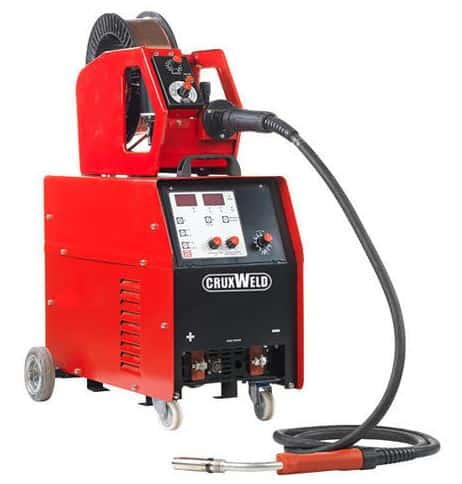
Metal inert gas welding machines are generally used for large and thick materials. In this, the welder needs to use a consumable wire as both an electrode and a filler material. This process is faster than TIG welding, resulting in a shorter time and lower production costs.
The machine works in single-phase, three-phase, and all in one. Stainless steel and aluminum metals can be welded easily using these machines. These types of welding machines are used in small businesses, manufacturing industries, and metal fabrication applications.
#2 TIG Welding Machine
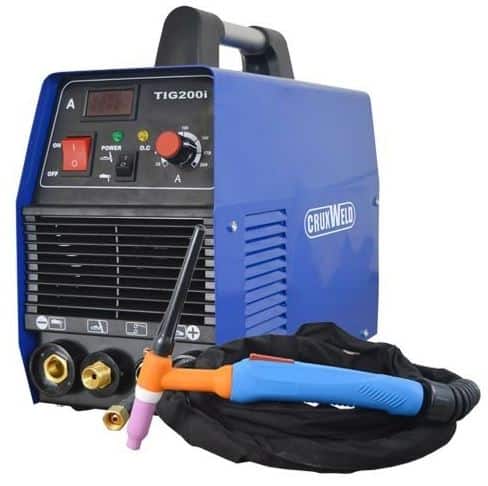
Tungsten inert gas welding machines are better for thin metals and smaller projects because they produce precise and clean welds. The welder must use a non-consumable tungsten electrode that produces a weld.
These types of machines produce a significant weld that is performed on metals such as mild steel, stainless steel, or aluminum. The most important applications for TIG welding machines are pipeline and pipe welding. However, it is used in many industries, such as aviation, aerospace, and sheet metal operations.
Read Also: What’s the difference between MIG and TIG welding?
#3 Spot Welding Machine
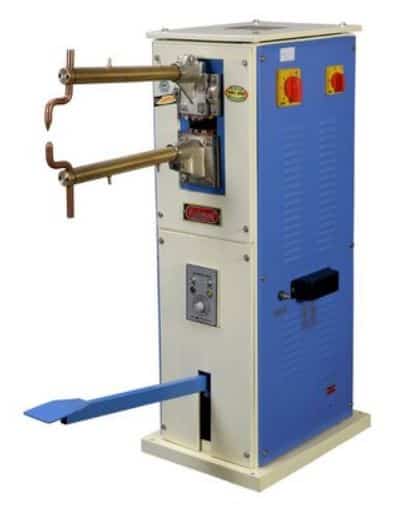
Spot welding is a resistance welding used for welding two or more metal sheets together by applying pressure and heat to the weld area by electric current. These machines have advantages such as effective power usage, high manufacturing rate, simple automation, etc.
spot welding machines are most commonly found in the automotive industry. They are generally much cheaper than their alternatives. One drawback of using a spot welding machine is that it cannot weld thick workpieces. In addition, the weld will break or fail if the permissible pressure on the workpiece is not achieved.
#4 Thyristor MIG Welding Machine
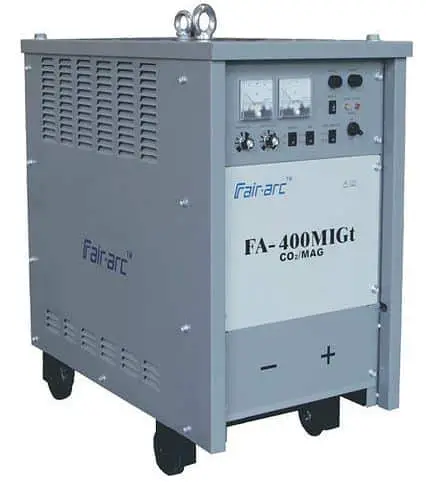
These types of welding machines are manufactured using the utmost quality of precision and hard ground parts. Most welders prefer this welding machine to fix objects or mount them on a suitable surface. These machines are great for welding solid core and flux materials.
The machine can provide high gripping strength and is widely demanded due to its dimensional accuracy, durability, and toughness. Thyristor MIG welding machines produce a small amount of spark, making them easy to control. They can easily weld metals like mild steel, low carbon steel, alloy steel, etc.
#5 Shielded Metal Arc Welding Machine
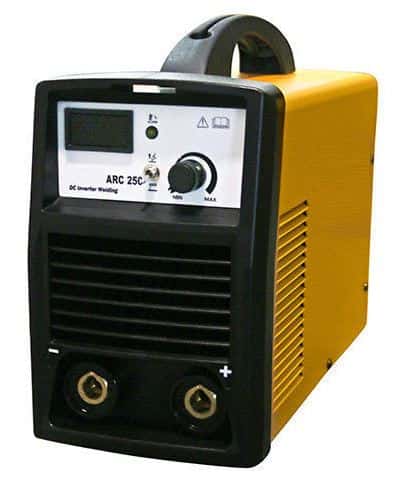
Generally, shielded metal arc welding machines work on the principle of heat produced by an electric arc. These are also known as stick welding, which uses an electric current flowing through the gap between the metal and welding stick (filler rod). SMAW machines are operated by both AC and DC currents.
The machine uses a filler rod that is covered with a flux which prevents oxidation and contamination by producing carbon dioxide gas during the welding process. SMAW welders are considered budget-friendly and economical compared to other machines. These welding machines are used for welding processes in the maintenance and repair industry.
Related: Types of Welding Defects: Their Causes and Remedies
#6 Flux Core Arc Welding Machine
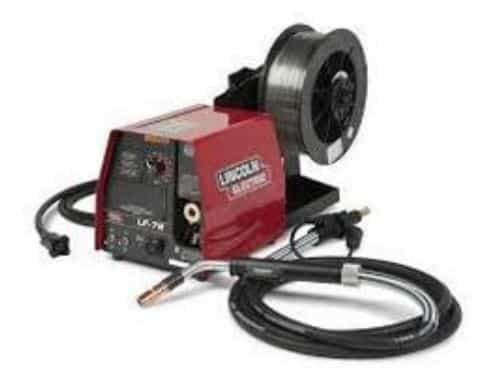
Flux core welding machines are generally used for welding thick metals. In this machine, the weld uses the heat generated by an electric arc to fuse the base metal at the joint area. FCAW machines are preferred for working in indoor and outdoor environments.
The flux-filled electrode is fed continuously so there is no need to stop and restart. These types of welding machines have less electrode waste and are known to produce some fumes during operation. Some FCAW welders can operate at extremely hot temperatures, approaching 1000 amps.
#7 Energy Beam Welding Machine
The machine uses a high-speed stream of electrons that is tightly focused using magnetic fields and applied to the materials to be joined. An energy beam welding machine has the ability to weld thick metals into thin metals. In addition, the welder can also join different types of metals.
These types of welding machines can weld specific points on metals. There is little or no heat distortion in the welded areas. Since the welder must perform this welding in a vacuum as the electron beam will be absorbed by the air, this machine is not for home use.
#8 Atomic Hydrogen Welding Machine
The AHW machine uses the arc generated between two tungsten electrodes and the hydrogen gas provided by a hydrogen gas cylinder. It is known as atomic hydrogen welding because the arc separates the hydrogen into atomic form.
These type of welding machines requires an experienced operator to operate this type of welder. This process is not used as much as GMAW and is slowly being replaced due to higher costs. AHW machines are used on thin and thick materials and are suitable for situations that require rapid welding.
#9 Submerged Arc Welding Machine
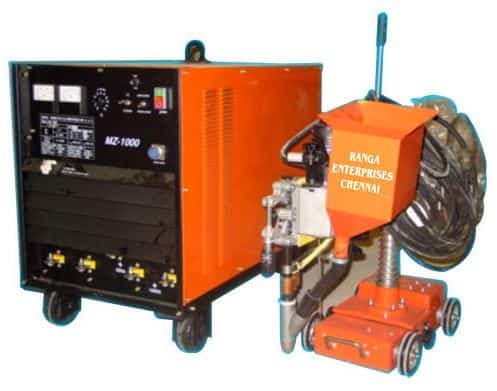
These machines usually involve the creation of an electric arc between a continuously fed electrode and the workpiece to be welded. This means there is no gas shield, but a powder flux. Submerged arc welding machines produce higher quality welds than other types.
In this type, the flux can be reused which minimizes the waste. Since it is an automatic or semi-automatic system, the operator does not require much experience to use this machine. The main drawback of this machine is that it is not a portable machine. These machines are commonly found in plumbing and pressure vessel applications.
#10 Oxy-Acetylene Welding Machine
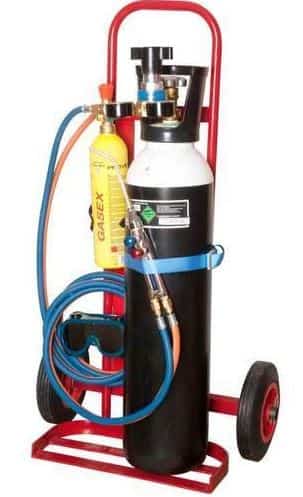
Oxy acetylene welding machine uses fuel gas along with oxygen as the heating medium. In this type of welding machine, the flame is considered to be the main element that is produced at the end of the torch. This flame melts the base metal and potential filler to form a continuous weld.
This machine is best for thin materials and does not work well on thick materials. An operator can effectively control temperature and weld beads using this machine. These welding machines are mainly used all over the world as it is relatively low cost and the machines are portable.
Checkout: How Does UnderWater Welding Works?
#11 Transformer Welding Machine
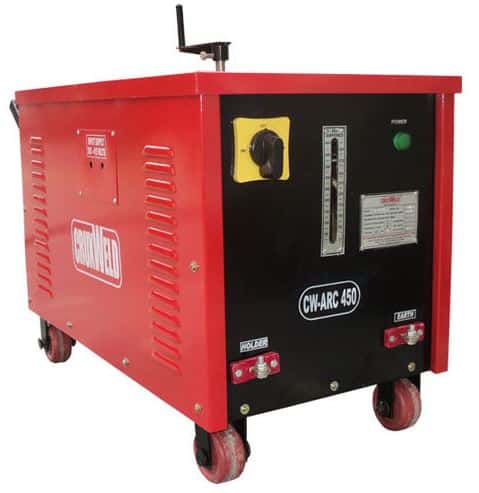
It is a step-down transformer that converts high voltage, low-amperage AC input current into low voltage, high-amperage AC welding current. The transformer welding machine can run on single-phase power.
Most of the AC power is created, and each time the polarity changes, the voltage passes through zero, making an unstable arc state. However, this problem has been solved by designing better compressive characteristics in the welder and better AC electrodes.
#12 Transformer-Rectifier Welding Machine
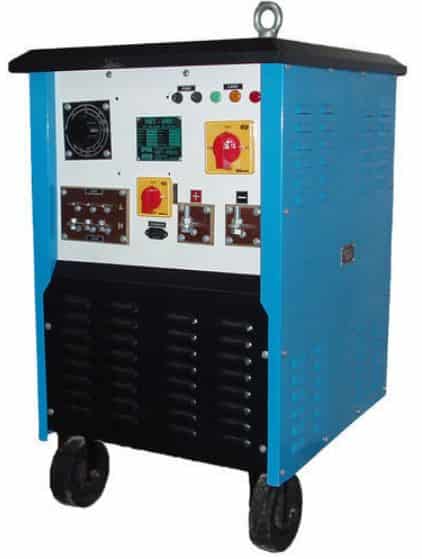
In this machine, the rectifier converts the input AC into output DC so that it can have negative and positive polarity. A single-phase rectifier welder is a type of transformer welder to which a rectifier is connected to obtain a DC output.
These welding machines are manufactured using rectifier technology for MIG welding. They offer controls to adjust current, voltage, and polarity for good welding performance.
#13 Rectifier Welding Machine
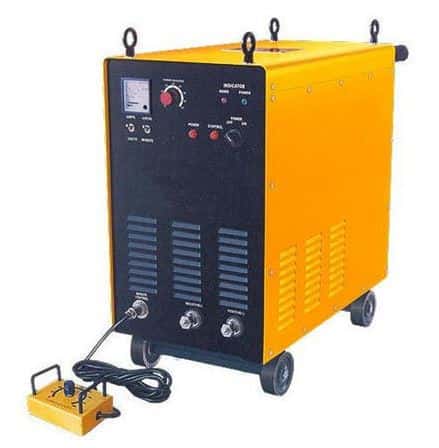
The rectifier welding machine works on an AC power source and can deliver high AC frequency and DC welding current. In this, three-phase AC is fed to the rectifier units, providing DC into a single output circuit.
Rectifier welding output is always a DC current that can be either a constant or a variable DC. It uses a diode, thyristor, or transistor to convert AC to DC for output. Different types of rectifier welders are available, however, all of them are similar in functionality and working.
#14 Plastic Welding Machine
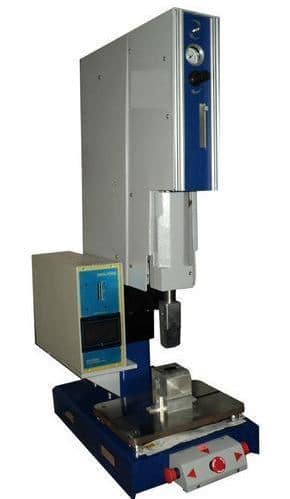
Plastic welding machines are used to join pieces of plastic and repair cracks. When welding plastic materials, materials are first joined and then pressurized. These welding machines provide better strength and reduce cycle times.
These machines are capable of welding many plastics such as polypropylene, high-density polyethylene (HDPE), PVC, CPVC, ABS, and even Lexan or polycarbonate, using several basic welding techniques.
#15 Multi-purpose Welding Machine
Apart from all these welding machines, some types are used as multipurpose. It means that some machines may offer different welding processes. If you don’t want to be limited in welding options, look for a welding machine that can handle more than one process.
There are some MIG welding machines that can operate as an FCAW. Also, TIG machines can act as stick welding machines. But the operator needs to buy additional accessories or change the welder’s setting.
Read Also: What is a Laser Beam Welding Process?
Factors To Be Consider When Selecting a Welding Machine
Despite knowing the different types of welding processes, welders need to choose the appropriate machine for the requirements. Therefore, the welder should follow the below points keeping in mind.
- Choosing regular or complex welding machine
- Weld-quality requirement
- Thickness of metal
- Consider welding conditions
- Choosing the right power source
- Types of metal and welders
- Choosing portable welding
#1 Choosing Regular or Complex Welding Machine
The choice of a welding machine depends on the skill level of a beginner or a trained welder. Beginners can select a basic welding machine such as a MIG welder.
On the other hand, if it is for a trained welder, you need a job with higher powers. Then you can choose a high-tech TIG welder as well.
#2 Weld-Quality Requirement
If you are looking for high-quality welding results, a TIG welder is a good option. Also, consider using a stick welder or flux-core welding machine if you are welding rusty or dirty metals and want to get stronger welds.
#3 Thickness of Metal
Typically, you must use a stick welding machine for thicker metals. Whereas for thin metals MIG or TIG welding machine is required.
#4 Consider Welding Conditions
The welder must always take care to check where the welding point is. Generally, a stick or flux-cored welder is ideal for rough outdoor conditions like wind, etc.
#5 Choosing the Right Power Source
DC output is generally considered to be a good option for welding steel and stainless steel metals. Aluminum and magnesium-type metals require AC output is a good choice. If the welder is required to weld a variety of materials, then select a combination AC/DC welding machine.
#6 Types of Metal and Welders
MIG welding machines are commonly used for welding stainless steel, steel, and aluminum alloys. Stick welding machines work well with stainless steel, steel, and cast iron. TIG welders are a better choice for all metals or alloys except cast iron.
#7 Choosing Portable Welding
You may need a portable welder if the power source is relocated. It is either driven by an engine or works with an inverter.
Wrapping It Up
In the end, I conclude that welding is a process of joining two metals. To do this, the welder must use a welding machine appropriately to achieve welding requirements. So, if you are a welder, you must know these welding machines to weld correctly.
So now, I expect I’ve covered everything about “types of welding machines“. If you still have any doubts or questions on this topic, you can contact us or ask in the comments. If you like this article then please share it with your friends.
Want free PDFs direct to your inbox? Then subscribe to our newsletter.
Download PDF of this article:
You might like to read more in our blog:
I found your explanation helpful when you informed us that a MIG welding machine is used for large and thick materials by using a consumable wire as both an electrode and a filler material for a welding process that is shorter and low on production costs. I will be opening a welding shop in Wodonga soon, so I need to invest in equipment and supplies to use for my new venture as well. I’ll keep this in mind while I look for an industrial supplier in Wodonga to contact about this soon for my new business.
Thank you for your kind words! Best of luck with your new welding shop in Wodonga. If you have any more questions in the future, feel free to reach out.
Hello sir, fantastic.
Thanks for your feedback.
HI……
Hello there.